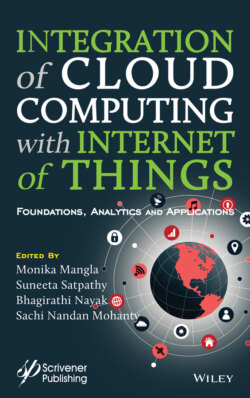Читать книгу Integration of Cloud Computing with Internet of Things - Группа авторов - Страница 20
1.3.2.3 IoT in Fog Computing (FC)
ОглавлениеFC reduces the amount of information to be carried into the cloud and improves efficiency by extending the cloud nearer to the data generating device known as the fog nodes. These fog nodes are in the form of controllers, switches, servers, routers, cameras, etc. which provide the desired storage, network connection, and computing features is known as fog node. In general, CC is incapable of handling large data bandwidth as it is subjected to volume and latency that’s leads to the advent of FC. It is found useful in compliance and data security and is a non-trivial extension of CC. It bridges several sensors appearing at the network edge to the core computing structure of the cloud [1, 23]. The system requires the processing to be carried out either on the network edge of a gateway device or router or in the data hub of the mobile device.
Although, the FC is similar to EC appear similar the key difference lies in the location or the placement of computing power and intelligence. The FC places the intelligence at the local area network to transfer the data from end-users to a gateway for further transmission. On the contrary, EC intends to place the processing power and intelligence in devices such as embedded automation controllers. The concept of cloud, Edge, and FC is shown in Figure 1.7.
Similarly, EC appears directly on the devices where the sensors or controllers are attached or it may appear at the gateway device physically nearer to the sensors. On the other hand, FC carries the edge activities to several processors connected to the LAN physically away from the sensors, controllers, and actuators.
Advantages of FC
Since in EC the storage and processing of data to take place in LAN, the technique allows the organizations for the aggregation of information from multi-devices to regional stores.
The data processing capability of Fog architecture is larger than that of Edge as the former allows organizations to gather data from different various devices.
It improves and helps the real-time processing capabilities of the Edge architecture.
It is most suitable for structures that have to handle millions of devices sharing information between them.Figure 1.7 The concept of cloud, edge, and FC.
It can provide a better quality of services, low latency, security, privacy protection, location awareness, reliability, etc. Hence, it can be efficiently employed in real-time applications than CC.
Disadvantages of FC
A major drawback of FC is the huge data dimensions it needs to handle with millions of devices.
It requires a large investment and consequently a large infrastructure to accommodate such volume of data and devices for reliability.
For large sensor data, it is difficult to use the cloud for transmission. Hence, it is essential to move to Fog architecture. Further, the data transmission between the sensors and the cloud or vice versa requires a large bandwidth that makes the CC inefficient. Thus, in the future, it is advisable to replace the CC with FC in the application such as a smart grid, low energy consumption, smart transportation system, smart traffic, management systems, agriculture, and health care system.
